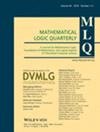论某些均质结构自变群的密集局部有限子群
IF 0.4
4区 数学
Q4 LOGIC
引用次数: 0
摘要
假设一个可数结构的每个有限部分同构都可以扩展为一个自形。埃文斯问:如果的年龄(有限子结构集)满足赫鲁晓夫斯基的扩展性质,那么其自形群是否真的包含一个密集的局部有限子群?为了研究这个问题,在过去的几十年里,人们引入并研究了赫鲁晓夫斯基外延性质的一个连贯变体。在其他结果中,我们根据相干扩展性质的(新)变体,为密集局部有限子群的存在提供了等价条件。我们还将我们的概念与其他相干外延性质进行了比较。本文章由计算机程序翻译,如有差异,请以英文原文为准。
On dense, locally finite subgroups of the automorphism group of certain homogeneous structures
Let be a countable structure such that each finite partial isomorphism of it can be extended to an automorphism. Evans asked if the age (set of finite substructures) of satisfies Hrushovski's extension property, then is it true that the automorphism group of contains a dense, locally finite subgroup? In order to investigate this question, in the previous decades a coherent variant of Hrushovski's extension property has been introduced and studied. Among other results, we provide equivalent conditions for the existence of a dense, locally finite subgroup of in terms of a (new) variant of the coherent extension property. We also compare our notion with other coherent extension properties.
求助全文
通过发布文献求助,成功后即可免费获取论文全文。
去求助
来源期刊
CiteScore
0.60
自引率
0.00%
发文量
49
审稿时长
>12 weeks
期刊介绍:
Mathematical Logic Quarterly publishes original contributions on mathematical logic and foundations of mathematics and related areas, such as general logic, model theory, recursion theory, set theory, proof theory and constructive mathematics, algebraic logic, nonstandard models, and logical aspects of theoretical computer science.

 求助内容:
求助内容: 应助结果提醒方式:
应助结果提醒方式:


